Headwear that performs protective, warming and hygienic functions – the most important accessory that should be present in the wardrobe of a newborn. The right model can be selected in the store, but it is much more pleasant to put on the baby a hat knitted with your own hands. Correct measurements of the head circumference will help you not to make a mistake with the size.
How to measure the circumference of a newborn's head for knitting a hat?
The circumference of a newborn's head is the main parameter that should be taken into account when purchasing a ready-made hat and when creating a pattern for the future product.
1
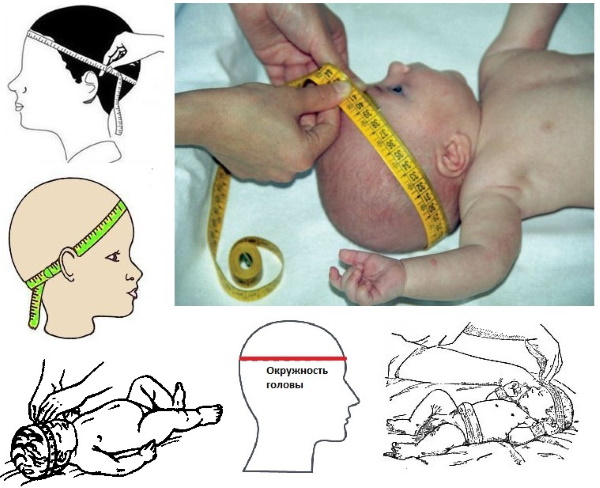
Its meaning can be found out:
| Way | Description |
| Based on the results of an ultrasound scan in the last months of pregnancy | This option is relevant if the baby is yet to be born. The doctor can judge how well the fetus is developing based on the head circumference. |
| According to the tables | There is a correlation between the age, weight of the baby and the size of its head. This correlation is the basis for tables that can be used if the item is, for example, to be presented as a gift. |
| Using a special formula | For babies from birth to 4 months it looks like this: OG = 43 – 1.5(6-A), where: · ABOUTG – head circumference; · A – age in months. For a newborn: OG = 43 – 1.5x6= 34. |
| Using independent measurements | This method gives the most accurate result and allows you to knit a comfortable headdress for your baby in the future, which will reliably cover the ears and the back of the head without slipping over the eyes. |
The newborn's head circumference is measured with a piece of soft, non-elastic tape that will not injure the delicate scalp. In addition to the tape, you will need a regular ruler.
When taking measurements, it is important to adhere to the following rules:
- Whatever tool is used, it must be absolutely clean: it is recommended to treat the measuring tape with a disinfectant solution, and iron the tape with a hot iron;
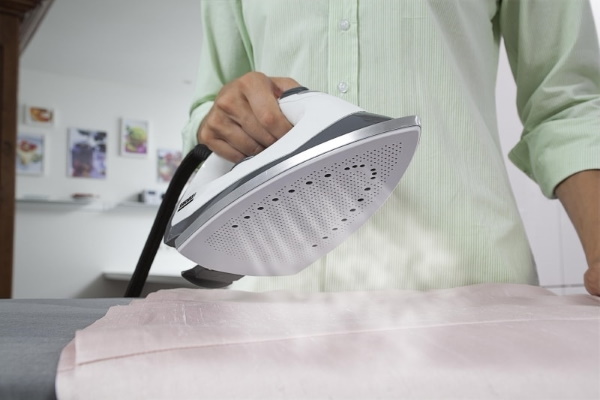
- To perform the procedure, you need to choose a time when the baby is calm and positive. It is not advisable to take measurements immediately after eating;
- To avoid distortion of the results, the newborn is placed on a changing table or on any hard surface covered with a clean diaper.
The tape fits snugly around the head, but does not squeeze it.
To get the correct measurements, it should go around the head at the following points:
- in front – above the eyebrows and parallel to them;
- from the side - above the auricles;
- behind - at the most protruding point of the back of the head.
It is quite difficult to correctly determine the location of the last point for a baby lying on his back, so it is recommended to take several measurements, slightly moving the measuring tape up and down. The largest result is selected from the results obtained.
Hat size for newborn boys and girls - differences and features
When choosing the right size, it is necessary to take into account that:
- During the first 4 months of life, the rate of head growth is the highest: the head circumference at this age increases by 1.5-2 cm every month;
- starting from the 5th month and up to 1 year, the growth rate slows down and amounts to 1 cm per month;
- At birth, boys' heads are approximately 1 cm larger than girls' heads (the average head circumference is 35 cm for a boy, 34 cm for a girl).
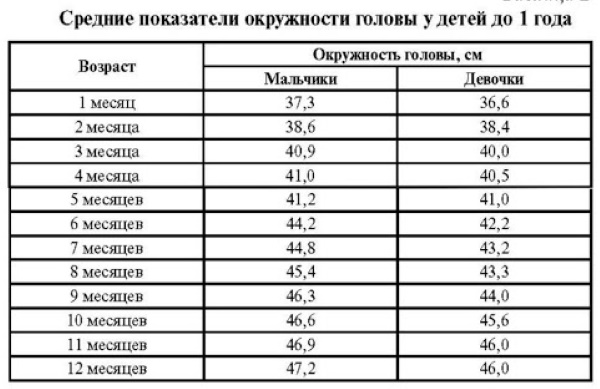
The rate of head growth for boys up to 4 months is higher than for girls of the same age.
This can be seen from the values given in the table:
| Age (months) | Average head circumference (cm) | |
| boys | Girls | |
| At birth | 35 | 34 |
| 1 | 37.3 | 36.6 |
| 2 | 38.6 | 38.4 |
| 3 | 40.9 | 40 |
| 4 | 41 | 40.5 |
Hat Size Chart for Newborn Girls by Month
The size of the hat usually corresponds to the head circumference in centimeters, the value of which is usually indicated on the label. Sometimes, the age and height of the child are indicated as an additional parameter, which allows you to more accurately select the size of the headdress.
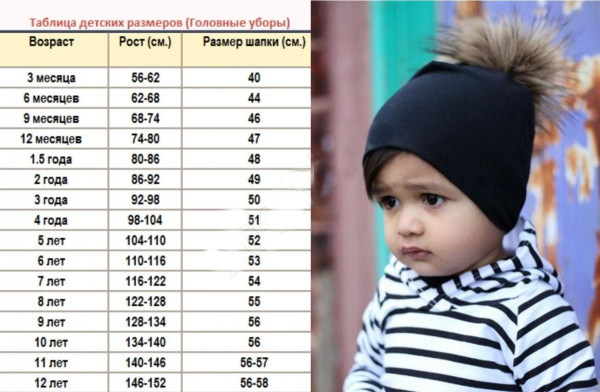
However, for knitted items, accuracy is not so important, so when choosing a hat or cap for a girl, you can use the following table:
| Age (in months) | Size (cm) |
| 0 | 32-38 |
| 1 | 35-40 |
| 2 | 37-42 |
| 3 | 39-44 |
| 6 | 41-46 |
Hat Size Chart for Newborn Boys by Month
When choosing a headdress for a boy, you can also take his age into account, but keep in mind that a “male” head is somewhat larger and, accordingly, a larger size will be needed:
| Age (in months) | Size (cm) |
| 0 | 34-39 |
| 1 | 37-41 |
| 2 | 39-43 |
| 3 | 41-45 |
| 6 | 43-47 |
To choose the best option from the proposed options, it is recommended to take into account the child’s height and weight (the head circumference is directly proportional to these parameters).
How does the purpose of the headdress affect the size?
There is a general rule: for headwear designed for summer and autumn-spring periods, the headwear is knitted strictly according to the obtained head circumference measurements. For winter hats worn over a lighter headwear, it is recommended to add 1 cm to the head circumference value.
Knitting hats, caps, hoods for babies
The circumference of the newborn's head is just one parameter that must be taken into account when knitting hats and bonnets. Rough internal seams, decoration in the form of beads or rhinestones are prohibited.

The finished product must:
- cover your ears and the back of your head tightly;
- sits well on the head and does not squeeze it;
- provide the child with maximum comfort.
Selection of threads
When choosing a thread for knitting, it is necessary to take into account that not every yarn presented on the market is suitable for these purposes.
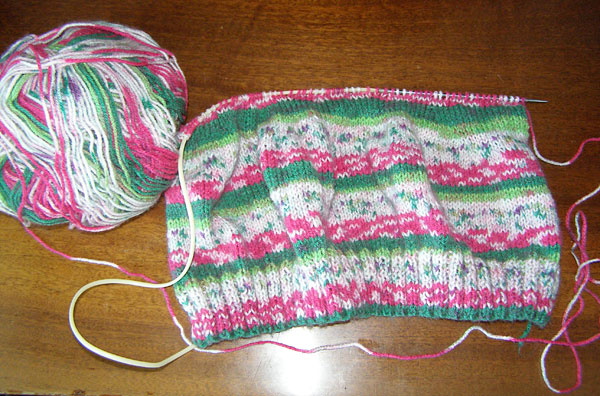
The main parameters to pay attention to are:
| Parameter | Description |
| Tactile sensations | The yarn should be soft and smooth. The following is not allowed: · prickly wool, which will cause skin irritation, even if the cap is worn over other headwear; · fleecy yarn (mohair, down), since its microparticles can get into the eyes, mouth or nose of the child. |
| Compound | If the baby is not prone to allergies, you can choose pure wool or semi-wool for winter clothes. For a little allergy sufferer, it is better to knit a hat from synthetic yarn (the best option is acrylic). For summer, thin cotton thread will do. |
| Color | It is not advisable to buy yarn of excessively bright colors, which involves the use of a huge amount of dye, which will subsequently come into contact with the baby's skin. It is better to opt for delicate pastel shades. |
| Thickness | The thicker the thread, the denser and warmer the knitted fabric will be. For lightweight hats, the thinnest yarn is selected. |
| Quality | It is imperative to check the thread for:
· strength: it should not tear when slightly stretched; · uniformity of thickness; · presence of foreign inclusions. For children's items, you should not buy yarn that has a noticeable "chemical" smell or is dyed with unstable dyes. |
The best options are considered to be:
- Alize Cashmere (wool);
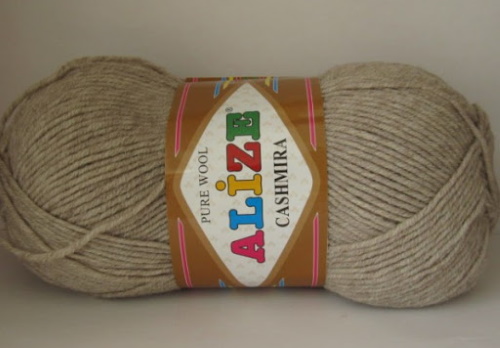
- Nako "Bambino Matik" (wool+acrylic);
- Pekhorka "Children's novelty" (acrylic).
Knitting needles, hooks
The appearance of the knitted fabric and the quality of the product depend on the correct choice of knitting needles or hook thickness. Sometimes this parameter is indicated on the yarn packaging, but if there is no such information, you can use a simple rule: the thickness of the knitting needles (hook) is equal to double the thickness of the yarn. It is recommended to fold the yarn in half, twist it not too tightly and stretch it slightly - this is the diameter of both the knitting needles and the hook.
It is important to choose the right material for the knitting needles, which will depend on the type of yarn:
- for artificial thread, the best option is knitting needles made of bamboo or plastic;
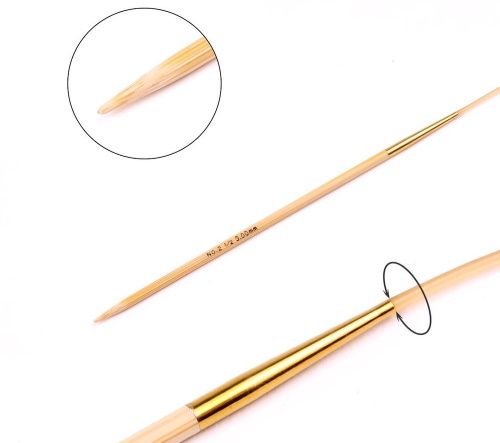
- for natural wool – aluminum knitting needles;
- For openwork knitting from cotton yarn - bamboo knitting needles.
When knitting a bonnet, you will need regular straight knitting needles; it is more convenient to knit a baby hat on 4 knitting needles. Circular knitting needles are not applicable in this case due to the miniature size of the product.
Calculation of knitting density
Knitting density or the number of loops that fit into 10 cm of the product length is an indicator necessary for determining the required number of loops.
To calculate the density you will need:
- Select yarn, knitting needles, pattern.
- Knit a sample (the longer it is, the more accurate the result will be).
- Iron it (without stretching).
- Measure the length using a ruler, for example, 20 cm.
- Calculate the number of loops in the sample: for example, 60 loops. This means that the knitting density is 30p/10cm. This is the horizontal density value. For complex items, you may also need to know the vertical density: the number of rows in 10 cm of knitted fabric. It is calculated using the same principle.

To avoid making a mistake with the amount of yarn needed, you can use general recommendations.
For example, for:
- a warm children's winter cap, which will be worn over the undercap, requires approximately 60-80 g of yarn (wool, semi-wool, acrylic). It is most convenient to knit it with knitting needles No. 3 or hook No. 2 (the number corresponds to the diameter in mm);
- To make a bonnet from thin yarn, designed for late spring-early autumn, you will need 50 g of yarn, knitting needles No. 2 or 2.5, hook No. 1.5 or 1.
The newborn's head circumference and knitting density are parameters that allow you to make a pattern for the future product and calculate the required number of loops. For example, you need to knit the simplest bonnet for a newborn with a head circumference of OG = 36 cm. The knitting density will be 30 loops per 10 cm.
Knitting starts from line AB, its length can be calculated using the formula: AB = 1.5 OG /2+ Pr1, Where:
- ABOUTG – head circumference;
- Pr1 = 6 cm – allowance, a constant value that does not depend on the size.
Substituting into the formula OG =36, we get AB = 33. This means that you will need to cast on 99 loops + 2 outer loops (the outer loops are not included in the calculation).
Width of cap AA1 calculated by the formula: AA1 = OG/4 +Pr2, Where:
- Pr2 – an increase of 2 cm, a constant value. For a head circumference of 36 cm.
AA1 = 11 cm. This means that from line AB you need to knit a piece of fabric 11 cm wide before you start knitting the back of the head (bottom). The bottom is a detail that adds volume to the product. In a bonnet, it is located at the back, covering the back of the head; in a cap, it is located at the top. The width of the back of the head DS can be calculated using the formula: DS = OG/4. Substituting the value of OG equal to 36 cm, we get DS = 9 cm or 27 loops. This means that on segments A1D and SV1 there are 36 loops, their length is 12 cm, equal to the length of the segments DD2 and SS2.
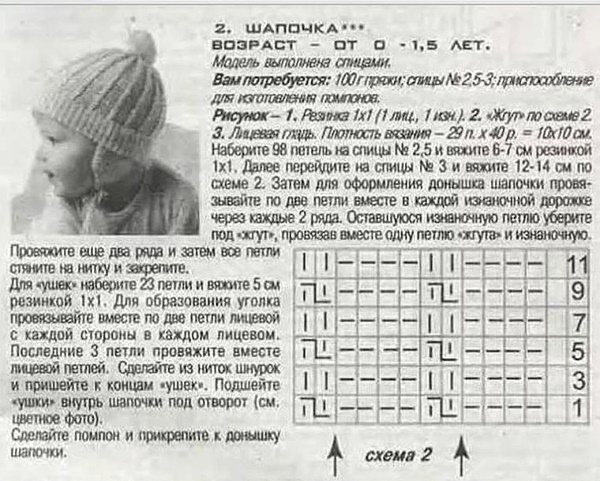
To give the cap a more aesthetic appearance and ensure its tight fit to the head, the first 3-4 cm are knitted with a 1x1 elastic band (alternating front and back loops), then you can move on to the selected pattern. The lower part of the cap, which will cover the baby's neck, also ends with an elastic band.
According to the presented calculation, a novice needlewoman can knit the blank and sew it, aligning lines A1D and DD2, IN1C and CC2. Next, you need to cast on the lower part of the cap (formed by segments AA)1, D2WITH2, IN1B) and knit several rows with an elastic band, after which provide the finished cap with ties.
Knitting hats and caps for children under 1 year
The advantage of knitted hats for babies compared to sewn analogues is their elasticity, thanks to which the item can be worn longer, remaining comfortable and performing its functions. Bonnet This is the easiest headwear for a baby to make. To knit it, it is best to use circular knitting needles for work. Knitting will be done in a stocking stitch. The elastic band is not knitted in this product.
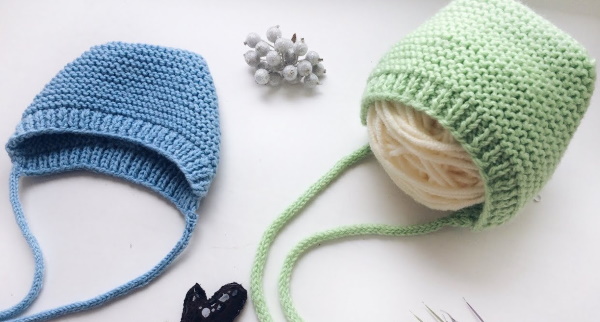
After all the loops have been cast on, you can begin knitting, knitting all the loops with the front method. When the headdress is knitted almost to the top of the head, you should begin decreasing the loops. This should be done evenly, there should be fewer and fewer of them in each row. As a result, there should be only one loop left, through which the thread is pulled and secured on the back side.
Newborn Princess Hat
Having heard such a name, the boy's parents will immediately think that this option is not for their child. However, this headdress will suit a baby of any gender. It was simply given such a name because it resembles the cap of Princess Charlotte on the day of her birth.
The following materials and tools will be required for the work:
- non-prickly yarn with parameters – 200 m/50 g;
- knitting needles No. 3, No. 2.75;
- additional spoke;
- several markers.
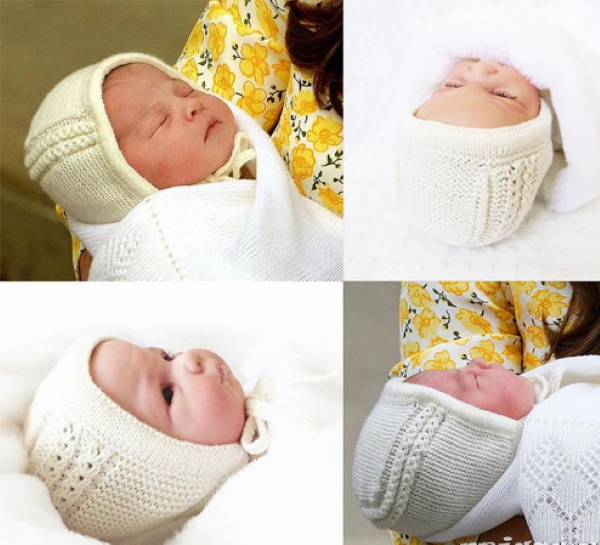
Knitting density – 28 sts = 10 cm.
Bonnet hat
The bonnet will provide reliable protection for the child from the winter cold and is well suited for discharge from the maternity hospital.
To knit such a headdress, you need to follow these steps:
- Create a scarf. To do this, knit the initial chain. Loops are collected taking into account the measurements taken.
- The stocking method is used for knitting. But you can use another method, alternating rows of air and face loops. As a result, the product will be elastic and warm.
- At the end of each row, the knitting must be turned over.
- When the scarf is ready, you should add a hood to it. From the wrong side of the row where you finished knitting the scarf, you should pick up loops, and then work in the same way.
- When the required amount of yarn has been knitted, the loops must be decreased.

- Once the work is completed, all that remains is to smooth out the seam.
Warm hat with ears
Hats in the form of cute animals are very popular. The model with brightly expressed ears, similar to an owl, looks very interesting. With this bird on your head, it is easy to stand out in the crowd. The owl is a symbol of wisdom and erudition.
To knit this, it is recommended to take yarn 135 m/50 g and knitting needles No. 2.
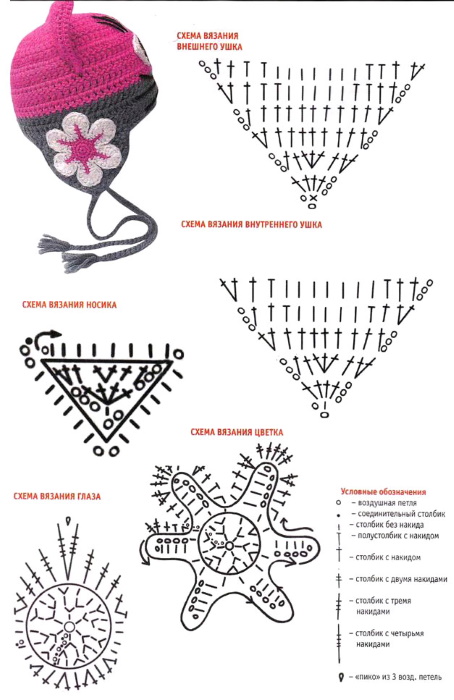
You need to cast on 37 sts on the knitting needle, as well as 2 edge sts. You should start from the central part with braids. You need to knit a quadrangle, the length of which corresponds to the distance from the back of the head to the forehead. The standard value of the head circumference for a newborn is 34 cm, for a month-old baby - 38 cm. A deviation in size of 3-4 cm is allowed. If it is not possible to measure the child's head for one reason or another, you need to use size tables.
Video on newborn head circumference for making a hat
How to make a hat for a newborn with knitting needles:
